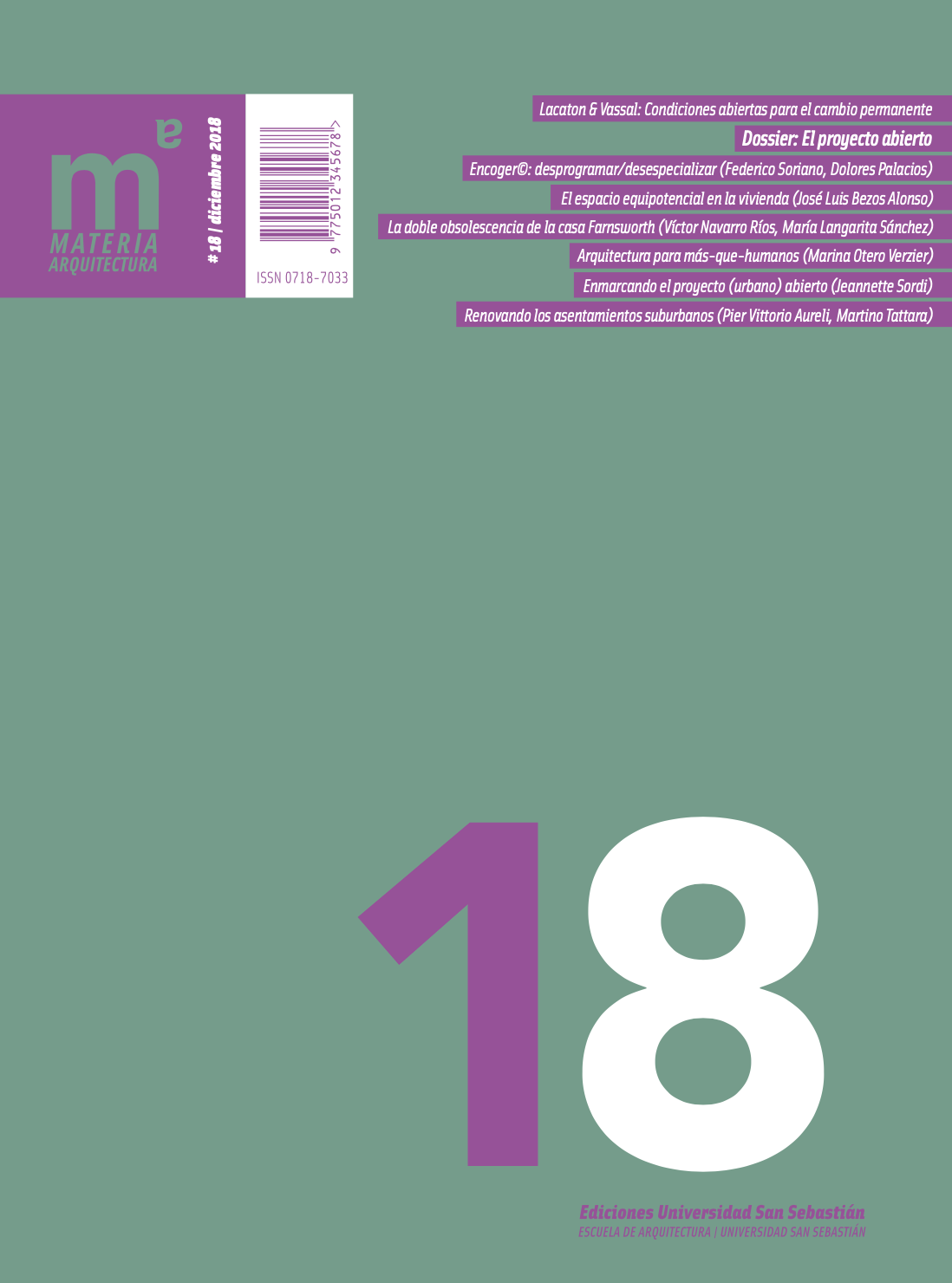Architecture for More-than-Humans
Barra lateral del artículo
Palabras clave:
Contenido principal del artículo
Resumen
In his project New Babylon (1956– 1974), artist Constant Nieuwenhuys proposes an alternative society that dedicates its time to creativity and play, and where human work becomes superfluous. Architectural paradigm of the free space and leisure enabled by the automation of work, New Babylon was also able to visualize the architecture of the post-labor world. A world that, fifty years later, is beginning to take concrete shape. Today, the architecture of full automation is being implemented in places like the Netherlands and China. Its introduction shakes the labor markets, as well as the configuration of human spaces and work tasks that have become obsolete with the emergence of machines in the production centers. These disruptive changes, however, could also be a trigger for the reinvention of the notion of human work and its architecture, from the perspective of its possible obsolescence. The architectural discipline faces the challenge of responding to the introduction of automation technologies. A research and innovation domain that still lacks a critical spatial perspective, automated architecture is, however, fundamental to discern an imminent future and, ultimately, to explore our agency and capacity to accept or challenge it.
Detalles del artículo
Materia Arquitectura proporciona acceso inmediato y gratuito a todos los contenidos de esta edición electrónica, publicada simultáneamente con la edición impresa. Materia Arquitectura no cobra honorarios a los autores por ningún concepto.
Todos los contenidos de esta edición electrónica se distribuyen bajo licencia Creative Commons de “Atribución-Copartirigual 4.0 Internacional” (CC-BY-SA).
La licencia Creative Commons permite el acceso libre e inmediato al contenido y permite que cualquier usuario lea, descargue, copie, distribuya, imprima, busque o genere enlaces a los textos completos de los artículos, permitiendo también que estos puedan ser rastreados para indexarlos, pasarlos como datos a software o usarlos para cualquier otro propósito legal. Asimismo, la licencia otorga derechos de uso a quienes a su vez utilicen una licencia abierta (Creative Commons o equivalente).
Los derechos de los textos y las imágenes publicadas pertenecen a sus autores, quienes otorgan a Materia Arquitectura la licencia para su uso. La gestión de los permisos y la autorización de publicación de las imágenes (o de cualquier material) que contenga derechos de autor y sus consecuentes derechos de reproducción en esta publicación es de exclusiva responsabilidad de los autores de los artículos.
Toda vez que mencionen su origen, los autores son libres de distribuir sus artículos por otros medios. Cualquier reproducción total o parcial del material deberá citar su procedencia.
Descargas
Citas
DONGGUAN CITY GOVERNMENT OFFICE. (2014, August 11). Dongguan City Promotion Enterprise ‘Machine Substitution’ Action Plan (2014-2016). Retrieved from www.dg.gov.cn/007330010/0202/201610/ b07a766c890749519e9aae37cc741efb.shtm
ERNST, D. (2016). Advanced Manufacturing and China’s Future for Jobs (East-West Center Working Papers No 8; p. 34). Retrieved from East-West Center website: www.eastwestcenter.org/publications/ advanced-manufacturing-and-chinas-future-jobs
FOUCAULT, M., & RABINOW, P. (1996). Space, Power, and Knowledge. In S. Lotringer (Ed.), Foucault Live: (interviews, 1961-1984) (pp. 340-341). New York, NY: Semiotext(e).
HUANG, Y. (2017). Can Robots Save Dongguan? — Barriers and Incentives to Automation in World’s Factory. Seminar Presentation at HKUST Institute for Emerging Market Studies. Retrieved from https://iems.ust.hk/events/ academic-seminar/2017/can-robots-save-dongguan-huang-yu
HUANG, Y., & SHARIF, N. (2017). From ‘Labour Dividend’ to ‘Robot Dividend’: Technological Change and Workers’ Power in South China. Agrarian South: Journal of Political Economy, 6(1), 53-78. Doi: 10.1177/2277976017721284
HUIFENG, H. (2015, July 1). Foxconn’s Foxbot Army Close to Hitting the Chinese Market, on Track to meet 30 per cent Automation Target. Retrieved from South China Morning Post website: www.scmp.com/tech/innovation/ article/1829834/foxconns-foxbot-army-close-hitting- chinese-market-track-meet-30-cent
INTERNATIONAL FEDERATION OF ROBOTICS. (2017).
Executive Summary World Robotics 2017 Industrial Robots.
Retrieved from IFR website: https://ifr.org/downloads/press/ Executive_Summary_WR_2017_Industrial_Robots.pdf
JAK, M. (2018, February 27). New Silk Road calls for Rotterdam to take on a Directing Role. Retrieved from Port of Rotterdam website: www. portofrotterdam.com/en/news-and-press-releases/ new-silk-road-calls-for-rotterdam-to-take-on-a-directing-role
KEANE, J. (2016, January 26). Automated Ports Have Dockworkers in the Netherlands Threatening Strikes - Motherboard. Retrieved from motherboard website: https:// motherboard.vice.com/en_us/article/z43xg3/automated- ports-have-dockworkers-in-the-netherlands-threatening- strikes
Dossier Translations
SE, B. (2016). Spotting Trends for China’s Manufacturing Future. CCTV. Retrieved from http://english.cctv. com/2016/05/19/ARTI6l4M7UqeO9OBuRpGYx5V160519. shtml
WIGLEY, M. (2018a). Constant Dialogue. In M. Otero Verzier & N. Axel (Eds.), Work, Body, Leisure (pp. 77-90). Berlin, Germany: Hatje Cantz.
WIGLEY, M. (2018b). Script for Venice [Text in the installation 'Work, Body, Leisure', Netherlands Pavilion at the Venice Biennale 2018, curated by Marina Otero Verzier].
WIGLEY, M. (2018c, May 26). Useful Life Podcasts (R. Boer, Collab.) [Part of the project “Work, Body, Leisure”, Netherlands Pavilion at the Venice Biennale 2018, curated by Marina Otero Verzier]. Retrieved from https://work- body-leisure.hetnieuweinstituut.nl/audio
YOUNG, L. (2018, May 26). Useful Life Podcasts (S. Niquille & A. Kornweitz, Collabs.) [Part of the project “Work, Body, Leisure”, Netherlands Pavilion at the Venice Biennale 2018, curated by Marina Otero Verzier]. Retrieved from https:// work-body-leisure.hetnieuweinstituut.nl/audio
Artículos más leídos del mismo autor/a
- Marina Otero Verzier, ARQUITECTURA PARA MÁS-QUE- HUMANOS , Materia Arquitectura: Núm. 18 (2018): Materia Arquitectura 18 (Diciembre/December 2018)
- Marina Otero Verzier, Ventilar. Cuerpos trabajadores, clima y arquitectura , Materia Arquitectura: Núm. 22 (2022): Materia Arquitectura 22 (Agosto/August 2022)
